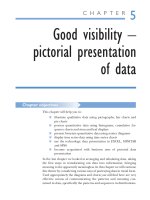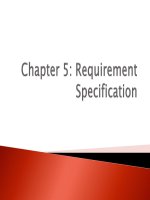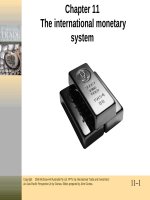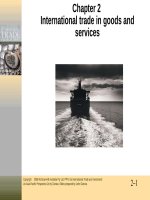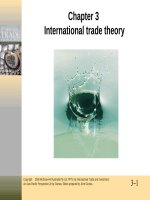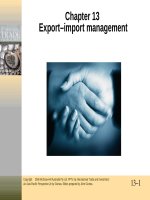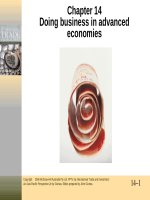Lecture International business - Chapter 5: International trade
Bạn đang xem bản rút gọn của tài liệu. Xem và tải ngay bản đầy đủ của tài liệu tại đây (1.85 MB, 35 trang )
5
International
Trade
Copyright © 2014 Pearson Education, Inc.
Chapter Objectives
•
Describe the relationship between international trade
volume and world output, and identify overall trade patterns
•
Describe mercantilism and explain its impact on world
powers and their colonies
•
Explain the theories of absolute advantage and comparative
advantage
•
Explain the factor proportions and international product life
cycle theories
•
Explain the new trade and national competitive advantage
theories
Copyright © 2014 Pearson Education, Inc.
5-2
Walmart
• Walmart and others import from China
• China imports from other countries, too
• Causes dramatic growth in global trade
Copyright © 2014 Pearson Education, Inc.
5-3
International Trade
Purchase, sale, or exchange of goods and
services across national borders
People have larger selection of products
Important engine for job creation
Copyright © 2014 Pearson Education, Inc.
5-4
Trade and World Output
• World trade
• 80% merchandise
• 20% services
• World output impacts trade
• Growing output = growing trade
• Sluggish output = sluggish trade
• World trade grows faster
than world output
Copyright © 2014 Pearson Education, Inc.
5-5
World’s Top Exporters
Copyright © 2014 Pearson Education, Inc.
5-6
Trade Patterns
Merchandise trade among:
Low- and
middle-income
nations
6%
High-income
nations
60%
34%
High-income and low- and
middle-income nations
Copyright © 2014 Pearson Education, Inc.
5-7
Who Trades with Whom?
Copyright © 2014 Pearson Education, Inc.
5-8
Trade Dependence and
Independence
Total
dependence
Total
independence
Potential effects of dependence:
+ Infuses needed capital
+ Creates jobs and raises wages
+ Imports technology and skills
– Economic problems transferred
– Political turmoil can spill over
Copyright © 2014 Pearson Education, Inc.
5-9
Discussion Question
What are the
patterns of global
and regional trade
flows that we see
among nations?
Copyright © 2014 Pearson Education, Inc.
5 - 10
Answer to Discussion Question
60 percent of world merchandise trade
occurs among high-income countries. 34
percent of world merchandise trade occurs
among high-income countries and low- and
middle-income nations. About 6 percent of
trade occurs only among low- and middleincome nations.
Intra-regional trade accounts for 71 percent
of Europe’s exports, 52 percent of Asia’s
exports, and around 48 percent of North
America’s exports.
This century is called the “Pacific century”
due to expected growth in Asia and a shift in
trade from the Atlantic to the Pacific Ocean.
Copyright © 2014 Pearson Education, Inc.
5 - 11
Trade Theory Timeline
Copyright © 2014 Pearson Education, Inc.
5 - 12
Foundations of Mercantilism
Nations accumulate financial wealth by encouraging
exports and discouraging imports
Three pillars:
▪ Maintain trade surplus
▪ Government intervention
▪ Exploit colonies
Copyright © 2014 Pearson Education, Inc.
5 - 13
Flaws of Mercantilism
‒ World trade is a zero-sum game
‒ Limits colonies’ market potential
‒ Constrains output and consumption
Copyright © 2014 Pearson Education, Inc.
5 - 14
Absolute Advantage
Ability of a nation to produce a good more efficiently than any
other nation (greater output using same or fewer resources)
Riceland
1 resource unit = 1 ton rice or
1/5 ton tea
Tealand
1 resource unit = 1/6 ton rice or
1/3 ton tea
Specialization and trade allows each to
produce and consume more
Copyright © 2014 Pearson Education, Inc.
5 - 15
Trade Gains:
Absolute Advantage
Specialization and trade:
+ Riceland gets five times
more tea than it would
have produced itself
+ Tealand gets two times
more rice than it would
have produced itself
Copyright © 2014 Pearson Education, Inc.
5 - 16
Comparative Advantage
Inability of a nation to produce a good more efficiently than
other nations, but an ability to produce that good more
efficiently than it does any other good
Riceland
1 resource unit = 1 ton rice or
1/2 ton tea
Tealand
1 resource unit = 1/6 ton rice or
1/3 ton tea
Specialization and trade allow each to
produce and consume more
Copyright © 2014 Pearson Education, Inc.
5 - 17
Trade Gains:
Comparative Advantage
Specialization and trade:
+ Riceland gets two times
more tea than it would
have produced itself
+ Tealand gets two times
more rice than it would
have produced itself
Copyright © 2014 Pearson Education, Inc.
5 - 18
Assumptions and Limitations
• Nations strive only to maximize production
and consumption
• Only two countries produce and consume
just two goods
• No transportation costs of traded goods
• Labor is the only resource used to produce
goods and it cannot cross borders
• Specialization does not create efficiency
and improvement gains
Copyright © 2014 Pearson Education, Inc.
5 - 19
Discussion Question
When a nation cannot produce
a good more efficiently than
other nations, but it can
produce that good more
efficiently than it does any
other good, we say this is a
case of __________.
a. Absolute advantage
b. Comparative advantage
c. Mercantilism
Copyright © 2014 Pearson Education, Inc.
5 - 20
Answer to Discussion Question
When a nation cannot produce
a good more efficiently than
other nations, but it can
produce that good more
efficiently than it does any
other good, we say this is a
case of __________.
a. Absolute advantage
b. Comparative advantage
c. Mercantilism
Copyright © 2014 Pearson Education, Inc.
5 - 21
Factor Proportions Theory
Countries produce and export goods that require
resources (factors) in abundance, and import goods
that require resources in short supply
Labor
Land and Capital
Two factor types
Copyright © 2014 Pearson Education, Inc.
5 - 22
Leontief Paradox
Research found evidence opposite of that predicted
by the factor proportions theory:
U.S. exports are more labor-intensive than U.S. imports
Possible explanations:
Theory assumes nation’s production
factors to be homogeneous
Theory is better predictor when
expenditures on labor are considered
Copyright © 2014 Pearson Education, Inc.
5 - 23
International Product Life Cycle
A company begins by exporting its product and later undertakes
foreign direct investment as a product moves through its life
cycle
Source: Raymond Vernon and Louis T. Wells, Jr., The Economic Environment of International Business, 5th ed. (Upper Saddle River, N.J.: Prentice Hall, 1991), p. 85.
Copyright © 2014 Pearson Education, Inc.
5 - 24
New Trade Theory
Fundamentals
Gains from specialization
and economies of scale
Companies first to market
create barriers to entry
Government may help by
assisting home companies
Copyright © 2014 Pearson Education, Inc.
First-mover advantage
Economic and strategic
advantage of being first to
enter an industry
May create a formidable
barrier to market entry for
potential rivals
5 - 25

